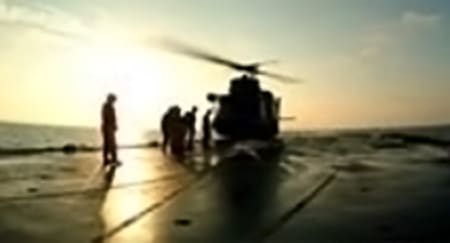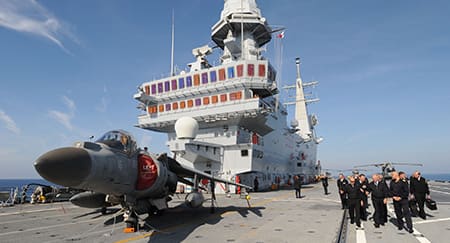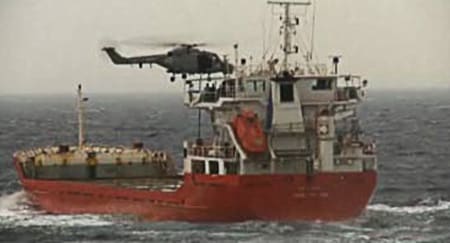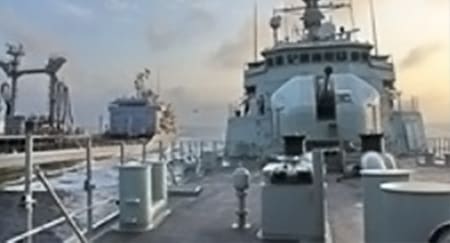Is it really the end of the naval era? Could there be more lawless areas of sea in the future? And how will climate change affect the maritime situation. Diego Ruiz Palmer looks into the issues.

NATO’s new Alliance Maritime Strategy
At a meeting held in Norfolk, Virginia, in July 2008, NATO’s top maritime commanders and its senior civil official in charge of operations agreed that the Alliance’s growing involvement in the conduct of maritime security operations (MSO), alongside more traditional naval tasks, required the development of a forward-looking Alliance Maritime Strategy and a supporting MSO Concept. Both documents are currently undergoing staffing at NATO Headquarters. All hands on deck
© CC-Mar Naples

NATO’s maritime capacity
In addition to the combined strength of the Alliance’s navies, NATO’s vast maritime capacity is composed of a constellation of discrete operational capabilities and technical skills resident in various bodies and staffs: the two allied maritime commands at Naples, Italy, and Northwood, United Kingdom, and the allied submarine command at Norfolk, Virginia, reaching back to a wider joint command structure; four standing multinational maritime surface groups, two of which are specialised in mine counter-measures, permanently subordinated to Naples and Northwood; four on-call multinational task forces led by France, Italy, Spain and the United Kingdom, and an additional one with an expanded task force capacity led by the United States, all available on rotation for operations by the NATO Response Force; the NATO Shipping Centre at Northwood; the Planning Board for Ocean Shipping; the NATO Naval Armaments Group; the Maritime Standardization Board of the NATO Standardization Agency; the Combined Joint Operations from the Sea Centre of Excellence at Norfolk; and the NATO Maritime Interdiction Operations Training Centre on the island of Crete, Greece.
Is naval competition going to take off?
© Italian MoD - Maurizio Sanità
Some observers of
the maritime scene have recently declared the rise of the “post-naval era”, one devoid of any prospect of the traditional, large fleet engagements last seen during the Second World War or that had been predicted between NATO maritime forces and the Soviet Navy had the Cold War turned hot (1). In this post-naval age, it is claimed, there is no need for navies built around the “capital ships” of our time – large aircraft-carriers with “arrested recovery” of their aircraft and high-end cruisers. Accordingly, navies – the United States Navy, first and foremost – should reorient their operational centre of gravity and their ship-building programmes away from blue-water operations on the high seas towards capabilities optimised for green and brown-water littoral and constabulary missions.
If this perspective is correct, and if we are indeed witnessing a genuine “revolution in maritime affairs”, this view is seemingly not yet shared by the world’s leading trading nations and naval powers. Despite being confronted with enduring defence spending constraints and large fleet recapitalisation challenges, most of them continue to invest in ocean-capable navies: witness the sustained efforts by Brazil, France, India, Italy, Russia, Spain, the United Kingdom and the United States to maintain, develop further or restore a carrier capability under one guise or another or, in the case of China, to acquire one (2), or the steady growth world-wide in the number and capability of helicopter-carriers and amphibious ships optimised for sea-control, power- projection, humanitarian assistance and forward presence (Australia, China, France, Italy, Japan, the Republic of Korea, The Netherlands, Spain, the United Kingdom and the United States).
Surely, the strategic myopia that in this post-naval age such ship-building programmes would seemingly convey cannot be ascribed solely to the bureaucratic skills of admiralties or the successful lobbying of ship-builders the world over. Yet, few would dispute that, twenty years after the end of the Cold War, globalisation and the remaking of the world’s geo-economic map requires that a fresh look be taken at the contribution which capable maritime forces can and, indeed, already make to a range of missions, from deterrence and crisis-response to forward engagement and the maintenance of a secure, safe and ecologically-protected maritime environment.
Such an assessment should help guide security policy, as well as naval planning and ship-building programming, and the conduct of joint and maritime operations. NATO is in the midst of such an effort and its outcome will have implications for how the Alliance wishes to contribute collectively, and with what mix of multinational capabilities, to maritime defence and security in the decades ahead.
The enduring prosperity of the world’s industrialised democracies owes much to world maritime spaces having been, by and large, secure and safe for commerce.
The world’s maritime commons have been, with a few exceptions of time and place, a “zone of peace” and a highway to prosperity for all mankind for over six decades. Seaborne commerce has more than quadrupled in volume over the last half-century. It now stands at over 90 percent of world trade and includes 60 percent of all petroleum exports. These seaborne trade flows are sustained by a fleet of some 50,000 major merchant vessels of various types and sizes, including a new generation of super tankers and container ships, as well as large cruise ships.
The enduring prosperity of the world’s industrialised democracies, despite successive economic down-turns, as well as the steady rise of new economic powers, such as Brazil, China and India, owes much to the fact that, since the end of World War Two, the world’s maritime spaces, which cover over seventy percent of the Earth’s surface, have been, by and large, a secure and safe domain for commerce.
Freedom of navigation is a principle embraced by all nations, irrespective of size, geographic location, political system, economic wealth or military capability. This is an important, positive legacy of the second half of the 20th century, which too often is unappreciated. Some observers refer to this attitude of benign neglect towards maritime issues as “sea-blindness”, at a time when there is mounting evidence that ensuring a steady state of maritime security in the decades ahead, as seaborne trade continues to grow, will require an expanding commitment of resources and capabilities and ever higher levels of international cooperation.
Potential challenges to security in the maritime environment
The maritime environment that is emerging in this second decade of the 21st century may, indeed, not be as peaceful and “user-friendly” as it once was. The explosion of seaborne trade and the resulting crowding of well-travelled sea routes, choke-points and harbours, together with the rise of illicit activities at sea, from human trafficking and piracy to terrorism and the covert transport of weapons of mass destruction (WMD) and their delivery means, require fresh thinking regarding the connections between these diverse geographic locales and risk factors, and a new, broad-based approach to maritime security and defence.
This changing environment presents the international community with three main challenges: a rising tide of diffuse, multi-faceted lawlessness at sea; the risk of strategic naval competitions, possibly leading to the temptation to employ maritime means for the purpose of political intimidation or military coercion, short of outright aggression, or even to big power conflict; and the potentially adverse impact of climate change on maritime security. Assessments of these dangers share a considerable degree of uncertainty regarding the exact scope of their prospects, interactions and implications.
Ungoverned maritime spaces could become a vast refuge for non-state criminal groups of all sorts, but also, potentially, for nation-states that may sponsor illicit activities, such as terrorism or WMD proliferation
Left unchecked, expanded lawlessness could have a steadily growing adverse impact on seaborne trade and travel, as well as on the reliability of energy supply, leading to an erosion of trade and trust among nations and declining prosperity for all. Ungoverned maritime spaces could become a vast refuge for non-state criminal groups of all sorts, but also, potentially, for nation-states that may sponsor illicit activities, such as terrorism or WMD proliferation. Exceptionally, new seaborne risks may involve the striking of naval vessels, such as in the case of the terrorist assault against the US Navy destroyer USS Cole in Yemen in 2000 or the missile attack of an Israeli warship off the coast of Lebanon by the Hizbollah group in 2006. Piracy off the coast of Somalia is a concrete illustration of an old, but now resurgent problem.
At the other end of the risk spectrum, the naval ship-building programmes of major powers in Asia ostensibly aim at acquiring an indigenous capacity to patrol and protect the sea lines of communications which underpin their newly acquired major trading partner status, making them welcome stake-holders in the pursuit of enhanced maritime security. International counter-piracy operations in the western Indian Ocean, as well as multinational maritime exercises involving an expanding number of Pacific basin nations, are compelling illustrations of this positive trend. But these programmes may also carry with them an embedded sea-denial capability that could be a source of mutual suspicion, as well as of concern to other major trading nations.
Naval competitions may have more immediate implications for regions of the world other than the North Atlantic Treaty area, yet given the world-wide trading interests of all Allies, and their shared strategic interest in preserving international peace and security, NATO is unlikely to wish or be able to remain indifferent to any adverse developments resulting from unchecked naval races. Here, an ocean-going forward presence and deterrence capability could make a disproportionately beneficial contribution to conflict prevention efforts. At the same time, the experience of the Cold War suggests that nuclear powers are very unlikely to allow naval competitions or isolated maritime incidents escalate into full-scale confrontations. Furthermore, the steady rise of seaborne trade and travel represents a formidable global bulwark against attempts to place this achievement at risk.
Climate change is likely a more distant but, potentially, no less formidable source of danger for security in the maritime commons, as well as for the safety and welfare of populations living in coastal areas, than the risks outlined above. Resource depletion, environmental degradation and more severe weather patterns, on land and at sea, could combine into a “perfect storm” with identifiable, potentially catastrophic consequences but still uncertain prospects.
Implications for naval planning and ship-building programming
In this complex, and potentially dangerous, geo-strategic and maritime environment, prudence should not play second fiddle to audacity or austerity in the determination of future fleet requirements. This is why the on-going debate over whether the US Navy is correctly structured for the emerging security environment is, in many ways, misplaced, and this for three reasons. Firstly, for decades to come the centre of gravity of the US Navy will continue to be its carrier battle groups and other expeditionary strike and amphibious groups, even if it were to forego the building of a follow-on class of large aircraft-carriers. The US Navy inherited from World War Two an operational experience and a technical know-how in the planning, procurement and operation of a carrier-centred fleet that is unique and unrivalled, and which the United States has maintained over more than six decades at considerable cost and with admirable resolve. This is not a strategic capability that the United States should consider shedding, at least not until the more salient features of the 21st century security environment become more firmly established and suggest that such a capability will become redundant.
For the foreseeable future, only the US Navy will be able to provide the backbone of that strategic, "over-the-horizon" capability
Secondly, it is unlikely to be advantageous for the international community in general, and for NATO in particular, to see the US Navy exchange its ocean-going fleet for a more littoral-oriented maritime capability -- even if a rebalancing in favour of corvettes and green-water patrol crafts is desirable for operational, as well as budgetary reasons -- for an overriding reason: maritime security operations, which inherently have a geographically localised focus, even if they address ubiquitous risks, can only be truly effective if they take place under the “umbrella” of a broader, trans-oceanic maritime capability, with its global reach and world-wide information superiority.
For the foreseeable future, only the US Navy will be able to provide the backbone of that strategic, “over-the-horizon” capability, which acts as an enabler for more littoral-oriented, tactical maritime security operations and regional capacity-building activities. Lastly, at a time when the United States has been promoting a broad-based, inclusive international approach to maritime governance and security, built upon an expanded network of partnerships between the US maritime services (Navy; Marine Corps; and Coast Guard) and those of other nations, it would be paradoxical and misguided to see the US Navy attempt to fill requirements and build capabilities for littoral operations that the navies of many allied and friendly nations could address more easily, quickly, and often with greater skill, because of their particular experience and expertise in, as well as tailored capabilities for, such operations.
Instead, the rise of global maritime partnerships is an opportunity to explore a more concerted international approach among like-minded nations towards the apportionment of missions on a regional basis, the sharing of tasks and best practices, the provision of mutual operational and logistic support, the exchange of information in support of law enforcement at sea, and the conduct of combined training and exercising. Both as a military hub for operational cooperation and as a political forum for consultation on maritime matters, NATO can be an important actor and enabler in this endeavour.
NATO’s distinct role and contributions
As an Alliance composed of many nations with proud seafaring traditions, global trading interests, and extensive naval capabilities, the maritime dimension of security has been of central importance to NATO since its inception and is today at the heart of NATO’s contribution to a comprehensive approach towards maritime security. In many ways, NATO is, at its core, a maritime alliance. The Atlantic Ocean and the Mediterranean, Baltic and Black Seas unite, geographically and strategically, the Allies. They are an essential part of their common heritage and shared destiny.
As the Alliance contemplates the completion of a new Strategic Concept at the forthcoming summit meeting in Lisbon, NATO’s maritime dimension is at the top of the Alliance’s agenda
NATO’s maritime forces perform enduring deterrence, reassurance and defence missions, as well as newer tasks in support of crisis-management and maritime security which often involve forward engagement with non-NATO partners, such as Australia, Finland, Japan and Ukraine, the world over. At any one time, Allied vessels and supporting assets may be engaged in Operation Ocean Shield – NATO’s contribution to determined international counter-piracy operations in the Indian Ocean – or participating in NATO’s counter-terrorism maritime operation in the Mediterranean Sea – Operation Active Endeavour – or exercising with the navies of the nations currently participating in NATO’s Istanbul Cooperation Initiative – Bahrain, Kuwait, Qatar and the United Arab Emirates -- or with a Partnership for Peace country like Sweden in the context of the NATO Response Force.
Through their embedded ocean surveillance capabilities and routine presence and engagement activities, Allied navies and their counterparts from NATO’s partner nations, contribute, in cooperation with civil law-enforcement agencies, to the generation of an authoritative representation of all maritime traffic extending eastward and westward from Europe. In all cases, interoperability and operational effectiveness are assured through reliance, in a collaborative environment, on common NATO tactics, techniques and procedures, backed-up by an extended constellation of knowledge hubs and other maritime-oriented capacities. NATO is truly a maritime alliance in action.
As the Alliance contemplates the completion of a new Strategic Concept at the forthcoming summit meeting in Lisbon, NATO’s maritime dimension is a key topic on the Alliance’s agenda. The naval era is not gone, but a new maritime age is arising.


